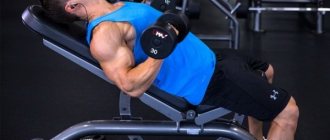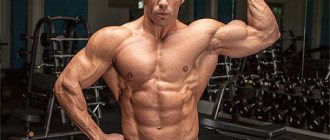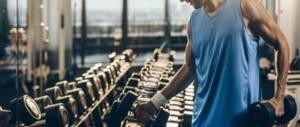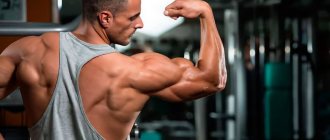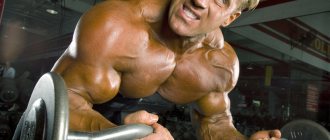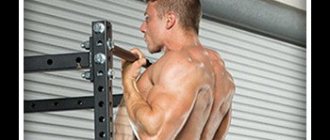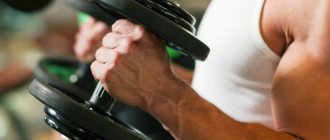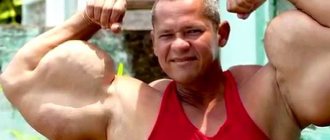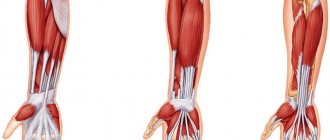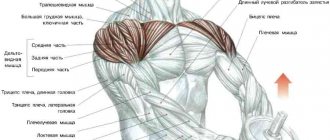Problem Area: Lower Biceps[edit | edit code]
“What, biceps again? Well, how much can you write about him?!” - some impatient readers will exclaim. Yes, we are again turning to the topic of development of the biceps brachii muscle, but this time we will not consider its entirety, but only one small area - the bottom. After all, biceps are not only a peak, the acquisition of which is often where the main efforts are directed. In order for this muscle to look harmonious, it must have almost the same thickness along its entire length. But not everyone can achieve this thickness in the lower part and not always.
Additional information[edit | edit code]
- Biceps - exercises and training features
- Specialized training, hands
- Arm training program
- How to pump up arm muscles
- An effective program for pumping up your arms
Correcting nature's mistakes[edit | edit code]
The general appearance of a particular muscle is determined genetically. The most important factors are the number of fibers in the muscle and their thickness, the length of the tendon with which the muscle is attached to the bone, as well as the point of attachment of this tendon. If you manage to change the last two parameters, then only operationally. But it is still possible to try to change the general appearance of the muscle - by purposefully influencing its individual areas. Such a famous coach as Oscar Ardon, who trained, in particular, Kai Greene and Evan Centopani, insists on this. Centopani believes - and not without reason - that a targeted impact on the middle of the biceps occurs if in the initial position the arm is lowered straight down. If you need to “load” the bottom of the biceps, then in the initial position the angle between the arm and the body should be 45-60 degrees. That is, curls should be performed on a Scott bench or in a biceps machine. You can also perform barbell curls while seated—in the starting position of this exercise, the arms and barbell rest on your hips. But Charles Glass, in order to shift the emphasis to the lower biceps, suggests recalling such a now half-forgotten exercise as standing barbell curls with “pull-ups”. When performing this exercise, the bar slides along the body, and the elbows are pulled back. At the top point of the amplitude of movement, the bar of the bar does not reach the lower section of the chest.
Dumbbell bicep curl (Scott bench)
Lifting dumbbells for biceps in a Scott bench develops the middle and bottom of the biceps, an isolating exercise, lengthens the bottom and raises the peak of the biceps. You can perform the exercise either sitting or standing. The main thing is to adjust the height of the music rest (an inclined stand for the upper arms) so that when lifting the barbell, the torso is always straight and the torso is in a vertical and stable position. Take an EZ barbell (its bar resembles the letter “W”) or a dumbbell with an underhand grip. Sit in a Scott bench and press your upper arms (triceps) firmly against the music stand. Lower the barbell and bend your elbows slightly. The elbows are placed on the music rest, closer to the bottom edge and should always remain motionless. Take a deep breath and hold your breath. Squeeze your biceps and lift the barbell up. As soon as your forearms are in a vertical position, exhale, pause for a moment and tighten your biceps even more. Slowly lower the barbell until your arms are almost completely straight. Take a short break and begin the next repetition.
Brachialis[edit | edit code]
Under the biceps - in its lower part - is the brachialis. By developing this muscle, we ensure that the biceps is pushed upward. This is especially true for its lower part. There are not many exercises for the targeted development of brachialis, but they exist. In particular, dumbbell curls with a hammer grip are considered one of the best. But there is an exercise that gives a much better result: bending your arms behind your head on an overhead block.
This exercise is performed as follows: you grab the handle of the upper block with a narrow lower grip (I hope you understand which block we are talking about: the one in which you usually perform back exercises), sit down, lean forward and begin to bend your arms behind your head. At the same time, your elbows diverge to the sides. Find a position where you can lower the handle as low as possible, almost touching your neck.
Exercises to develop the inner biceps – Evehealth
The content of the article
The biceps is a small muscle that is responsible for flexion, extension and rotation functions. It consists of several parts - external and internal muscles. Every athlete knows that during training it is necessary to perform exercises for the biceps of the internal part. It is she who, when she increases in size, seems to push out the outer part of the biceps, making her arms more muscular.
Now we will look at the most effective exercises for the inner biceps. But first we should talk about some rules, the observance of which will allow you to quickly achieve your goals.
Recommendations for pumping up the inner biceps
To help your inner biceps grow in size and not just improve your endurance, you need to follow some guidelines.
Firstly, in any sport, quality comes first, quantity last. After all, the better you perform all the exercises, the faster you will achieve positive results. Therefore, you should not squeeze out all your strength.
It’s better to do fewer repetitions, but as needed, or a lot, but to no avail.
Secondly, all exercises should be performed in several approaches. The breaks between them should be 1-2 minutes, but no more. And before you start the workout itself, you need to warm up your muscles.
It is important!
You can run, make circular movements with your arms, do squats, do push-ups several times, etc. During exercise, warmed muscles will work more actively.
In addition, this way you protect yourself from sprains and other injuries, because in order to pump up the inner biceps, you will have to lift weights.
Third, you should drink plenty of water during your workout. This will replenish fluid losses and activate the process of removing toxins from the body. This rule should not be neglected.
Since cleansing the body of toxins leads to faster metabolism and improves muscle growth. The growth of muscle mass is also affected by high consumption of protein foods.
So, if you want to quickly achieve your goals, you will need to spend some time on a protein diet.
And fourthly, be prepared for the fact that active training will lead to “side effects”. Together with biceps, you can pump up the muscles of your back, chest and abdomen.
Naturally, the best results can be achieved if you work out the inner biceps of your arm under the guidance of a trainer in the gym. But if you do not have this opportunity, you can perform the exercises described below at home.
Helpful advice!
To do this, you will need to purchase various sports equipment (dumbbells, barbells, horizontal bars, etc.).
And remember, independent training at home requires constant monitoring of the exercises, breathing during exercise and body position (the back should always be straight and the muscles should be tense).
Effective exercises for pumping up the inner biceps
How to pump up your inner biceps? Everything is very simple. This part of the biceps works during all strength exercises. Therefore, in this case, we can recommend classic exercises with a barbell and dumbbells.
When choosing exercises with a barbell, you first need to decide on the load. It should not be too large, as you may get injured, and you will not be able to do the recommended number of repetitions. But you shouldn’t use a small barbell weight either, since training with it will not give positive results. In this matter, it is necessary to find a middle ground.
You need to perform exercises with a barbell at home to pump up your internal biceps while standing. You need to grab the barbell with a reverse grip, this will greatly increase the effectiveness of your training.
Raise and lower the barbell slowly, while keeping your elbows motionless. When you lower the barbell down, you should not fully extend your elbows.
To achieve your goals faster, you should hold the barbell in each position for a few seconds - raise it, count to five, lower it, count to five again, etc.
You need to work the same way with dumbbells. Only in this case can you lift them simultaneously or alternately, and perform the exercise while standing or sitting. The main thing is to do it slowly and efficiently.
The most effective exercises for the inner biceps are exercises performed on a Scott bench or with an opposite grip, simultaneously bending and extending both arms.
Exercises for pumping the internal and external biceps
There is one complex exercise that helps pump up not only the inner head of the biceps, but also the outer one. And these are pull-ups on the horizontal bar. This exercise is truly one of the most effective, since when it is performed, almost all muscles work at once.
The exercise must also be performed with a reverse grip. In this case, the distance between the hands should be approximately 25-30 cm. To increase the effectiveness of the training, it is recommended to adhere to the following program.
You need to do 4 approaches. In the first and third approaches, you should do the maximum number of repetitions, and in the second and fourth, reduce the number of pull-ups by exactly 2 times.
Pay attention!
In this case, rest between approaches should not exceed 1 minute.
The biceps is a small muscle, so don't overload it. In order to pump it up, it is enough to perform 2-3 exercises in several approaches in one workout. And you need to borrow every other day, or even better, every day. And remember the recommendations given above. If you practice regularly and stick to them, you can quickly achieve your goal.
Video with the best exercises for biceps
Source: https://EveHealth.ru/uprazhneniya-dlya-razvitiya-vnutrenney-chasti-bicepsa/
Short head of the biceps[edit | edit code]
The biceps, as you certainly know, consists of two heads - long and short. From the point of view of the author of this article, the development of the lower part of the short head has priority - since it is somewhat shorter, it is precisely because of its insufficient development that a “failure” will be observed in the lower part of the biceps. Bending the arms with a barbell with a wide and very wide grip allows you to focus on the short head. And if we take into account everything said in the first chapter of this article, we can highlight an exercise that is almost of paramount importance for the development of the lower biceps: curling the arms with a barbell on a Scott bench with a very wide grip. At the same time, we work in a limited amplitude, excluding about a third of it at the top from the movement.
Grip[edit | edit code]
It is impossible not to say at least a few words about the grip. The grip should be such that the English word for it is loose. That is, not tough. A tight grip, in which your fingers are compressed very tightly, forces you to use your forearms to the maximum. Of course, there is nothing wrong with developing forearms. The problem here is somewhat different: the forearms will get tired before the biceps can receive sufficient load. So it’s better to constantly change your grip, choosing it in such a way (even open) that your forearms get tired as little as possible.
Direct your efforts precisely to the target[edit | edit code]
We have to repeat this over and over again: the biceps is a very small muscle, so heavy weights when working with it are simply contraindicated. Excess weight almost completely excludes you from working on the biceps, forcing you to perform the movement using your legs, shoulders, and back. Light weight not only allows you to direct your efforts exactly to the target, but also teaches you to very subtly feel the biceps and its individual sections. By working with moderate weights in the exercises listed in this article, you will very soon learn to feel exactly the lower part of the biceps. And from this moment the harmonious development of the biceps brachii muscle is literally a stone's throw away.
Source Iron World No. 3
Reverse grip barbell curl
The outer (lateral) part of the forearm, as well as the biceps. Formative exercise. Thickens the lateral part of the forearm. Grasp the barbell with an overhand grip (palms facing down) shoulder-width apart. Straighten your torso, bend slightly at the waist, straighten your shoulders and place your feet shoulder-width apart. Lower the barbell towards your hips. The arms are almost straightened. Take a deep breath and, holding your breath, lift the barbell to the level of your upper chest. While lifting, do not point your elbows forward; keep them motionless near your sides. At the top point, pause, tighten your elbow flexor muscles even more and smoothly lower the barbell.
